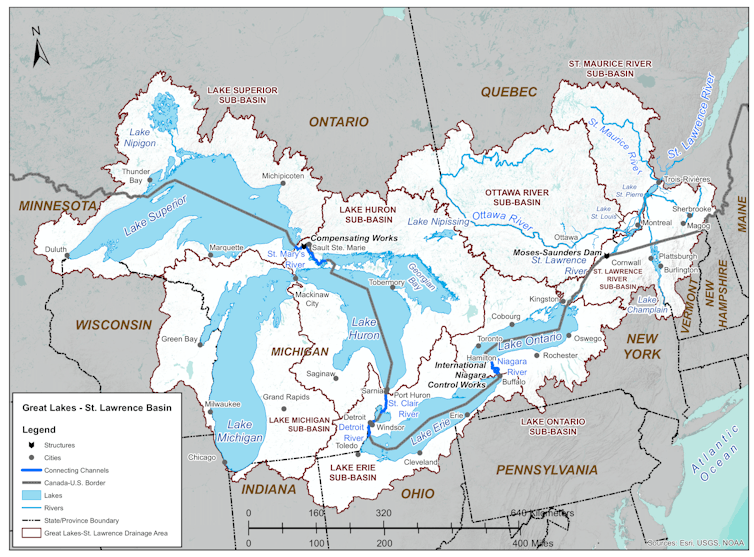On a quiet April morning, when the wind is low and the soil still damp from snowmelt, smoke rises like fog from Lake Simcoe’s De Grassi Point. Tongues of flame sprint through tall grass, creep beneath oaks and pines, lick at downed twigs and dead leaves. Within hours, four hectares in Innisfree, Ont., a neighbourhood of homes and cottages, will be scorched and blackened by fire. No one will call 9-1-1.
This isn’t a wildfire, an arson, or an accident. It’s a “good” fire, a prescribed fire that treats and heals remnants of a rare tallgrass prairie and red oak-white pine savanna. “It’s modelled after the natural burns that keep the savannas open and functioning,” says Conrad Heidenreich, a York University geography professor emeritus and a long-time cottager, now retired to the Point. “Burning kills invading trees and shrubs, and releases the seeds of savanna species that are adapted to burns.”
Fire “is an essential tool for this kind of restoration work,” adds Peter Shuttleworth, restoration project specialist with the Lake Simcoe Region Conservation Authority. Without the flames this tract of Ontario’s pre-settlement landscape—now designated a provincial Area of Natural and Scientific Interest (ANSI)—would be swallowed up by the surrounding forest.
“A fire that’s properly planned and managed is quite easily controlled,” Shuttleworth stresses. Timing is everything: ignite dead grass when there’s the right mix of wind, humidity, and moisture in the soil and vegetation, and the result is a low-intensity surface burn. Reptiles are safe in their burrows; mature trees may be singed but will survive. The roots and shoots of prairie plants lie safe in the dampness while flames torch the dry thatch, clearing invading shrubs and poplars. Done right, “it’s not a raging inferno,” Shuttleworth adds. “Most often, the burn is low and slow. It’s really only the grass and leaf litter burning.”
Still, the idea of a “good” fire is a tough sell after the smoky skies and the incineration of Lytton, B.C., last summer. Despite decades of fire prevention and lectures from Smokey Bear, there’s no shortage of “bad” fires that menace communities and burn so hot they sterilize soil and kill plant cover, with long-term environmental losses. The problem is what scientists call the “fire paradox”: the more you suppress fire, the more fuel stacks up in the bush, stoking catastrophic blazes in the future.
We may already be seeing the results. The area scorched by wildfires in Canada has doubled since the early 1970s and climate change is making the situation worse. Conservative projections suggest the area burned will double again—at the very least—by the end of this century. If “bad” fires are becoming more likely, it makes the idea of “good” fire more timely. What if careful burning can reduce the wildfire threat and offer ecological benefits too?
This idea is not new. As the continent’s original fire managers, “Indigenous people have been using fire as a good thing for millennia,” says Canadian Forest Service research scientist Amy Cardinal Christianson, a member of the Métis Nation of Alberta. “By burning in a low-intensity, controlled way, we use fire to improve the health of the plants and animals we depend on.” First Nations burned to protect settlements from wildfire and cleared undergrowth to aid travel. Fire promoted the growth of plants for food and medicine, created habitat for game birds and animals, cleared and nourished crop fields, sparked the regrowth of grazing lands, assisted in the hunt, and even controlled ticks that prey on deer and moose.
This type of Indigenous-controlled, early spring or late-fall fire never really disappeared, but modern fire suppression policies reduced it to a faint glow of its former self. Now, Cardinal Christianson and groups including the First Nations’ Emergency Services Society of British Columbia (FNESS) and the BC Wildfire Service are rekindling the practice.
“We’re trying to find out which communities are interested in cultural burning, what their objectives are, where they traditionally burned, and why,” adds Peter Hisch, FNESS forest fuel management specialist. Traditional benefits went beyond fire’s impact on the land: families worked together and passed teachings about land, language, and spirituality between generations. Hisch is trying to recapture this by making Indigenous culture “part and parcel” of modern First Nations fire management.
The result melds community wildfire protection with, say, the growth of saskatoon berries, or forage for deer and moose, or any of dozens of other benefits. “It’s almost like a social justice issue, putting Indigenous people back in a leadership role on their territories,” Cardinal Christianson says. “Good fire can help us preserve and promote our culture. Part of the result is healthy people, healthy nature, and a healthy environment.”
But there’s a long way to go. Provincial and federal funding is generally restricted to reserves, and “some reserves are so small they hardly encompass the housing,” Hisch says. Other First Nations prefer to run their own programs without the help or oversight of outside agencies. “As one-off, ad hoc projects we’ve been doing these burns for years,” Hisch adds. “But as a big, thought-out process with all the parties involved, we’re just starting out.”
De Grassi Point lies at another intersection of “good” fires, past and present. Five thousand years ago it was the eastern extension of a tallgrass prairie, a riot of tall grasses and wildflowers with names like big bluestem and sky blue aster. Sprawling from the centre of the continent during a warm, dry period, this empire of grass evolved with lightning-triggered natural fires. As the climate turned wetter and favoured forest growth, Indigenous fire maintained these eastern tallgrass prairies and savannas.
In 1793, Upper Canada’s lieutenant-governor, John Graves Simcoe, stopped at a Mississauga Village on De Grassi Point during an expedition to Georgian Bay. He bought corn from the Mississaugas—which was likely “grown on the area that is now the savanna,” says Conrad. Like the earlier Hurons (Wendat) and Petuns (Tionontati) to the west and northwest, the Mississaugas on Lake Simcoe used fire to clear and fertilize cornfields.
A side benefit was the production of red oaks. Shielded by their thick bark, oaks survived the fires that scorched competing maples and poplars. In turn, they shed acorns that could be harvested for flour or left on the ground to entice game including deer, bear, and wild turkey. Today, De Grassi boasts Ontario’s largest stand of red oak—a reminder of the days when at least 24-hectares of the point was a mosaic of Indigenous farm fields, oak groves, berry bushes, and a grassland-savanna hunting preserve, all maintained by fire.
Check out 7 tips that will help you prevent a forest fire
Now, when fire returns here, as it does every four or five years, it falls from a drip torch, seeding the fields with flaming drops of diesel and gasoline. When the torch ignites, “there’s nothing else happening in my mind beyond that particular moment,” says prescribed burn boss Jason Sickel, of Lands and Forests Consulting. To ensure the fire goes according to plan, “all my focus becomes the burn,” he adds. “It’s almost like meditation.”
With more than 20 years’ experience in prescribed burns, Sickel has spent months choreographing this burn, anticipating its moves, and preparing to conduct this performance. He has applied for permits, consulted with landowners and neighbours, and waited for the right mix of wind, temperature, humidity, moisture, and vegetation maturity.
As ignition time nears, Sickel’s crew ensures there is a fire break, clearing dead grass around the perimeter if necessary. They flush wildlife from the fire zone and patrol the boundaries of the blaze with water-tank-equipped ATVs. Because “communication is the key to success for a sustainable burn program,” Sickel says, neighbours are warned well head of time. “You have to get the information out there, let the community know what’s going on, and give them the opportunity to voice concerns.” Most people want to know the burn will be conducted safely—with good reason. “Grass is fine fuel. It ignites quickly and moves like the dickens in wind, faster than you can deal with it if you don’t know what you’re doing,” Hisch says. In most cases, prescribed burning remains a “don’t try this at the cottage” thing. (See “Is Burning for You?,” below.)
The site of these burns—there have been seven since 1998—is Innisfree, a 102-hectare family land trust set up by Conrad’s great-grandfather, Sir Edmund Walker. Humble circumstances limited Walker to an elementary school education, but he rose to become president of the Bank of Commerce (now CIBC) and to play key roles in building the University of Toronto, the Royal Ontario Museum, the Art Gallery of Ontario, and the National Gallery. He left the land for the use of his descendants.
“Most of those in the fourth to sixth generation still vacation at the Point in the 18 cottages and houses built by previous generations,” Conrad says. “All of us were raised as conservationists.”
Thanks to the burns, “the difference is amazing between what we had before and what we have now,” he adds. Though there are still problems with invasive plants including dog strangling vine, the prairie has expanded from an embattled 1.5-hectare plot to more than four hectares. “The tall grasses have spread through the length of the area, and there are such beautiful flowers coming up.”
And the next good fire? Probably 2026. “I’m seeing more interest in maintaining the prairie and savanna among my children’s generation,” Conrad says. “That gives me hope for the future.”
A volunteer firefighter for 26 years, longtime contributor Ray Ford has seen his share of “bad” and “it coulda been worse” fires, but not so many “good” ones.
Is burning for you?
Could your cottage neighbourhood host a prescribed burn? It can happen, but you’ll need a whole flock of ducks in a row: burns require months of planning, provincial and municipal approvals, and, in Ontario at least, an opportunity for public comment. Add in liability insurance and a professional crew to rein in the fire, and it’s a high-end weenie roast. At DeGrassi Point, the burn fee runs over $12,000, partly subsidized by a grant from the conservation authority and provincial property-tax relief for conservation lands. You’ll need a good reason for a burn—preserving ecologically rare habitat, for example—with burning as the best option. If there are too many homes and cottages nearby, a less incendiary approach might be better.
While growing in acceptance, these burns remain uncommon. Across northern Ontario last year Ontario’s Aviation Forest Fire and Emergency Services oversaw prescribed burns on 115 hectares—a miniscule fraction of the roughly 163,000 hectares wildfires singe during an “average” fire year.
Download this Canadian app that detects and tracks forest fires in real-time
This article was originally published as “Friendly Fire” in the May 2022 issue of Cottage Life.
Related Story 8 simple ways to reduce risk of fire at the cottage
































